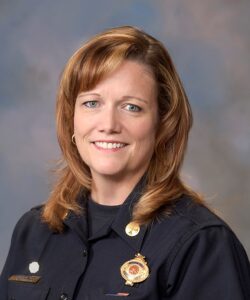
Fire Marshal Christine Reed’s Mission to Teach Fire Safety and Prevention in Northern California
“We can maintain our area’s natural beauty while still reducing wildfire risk. Since the first day of my career, my goal has always been to leave somewhere safer than it was when I got there.”
Christine Reed has worked in fire service positions for 31 years and strives to educate communities to raise fire safety awareness. As a lifelong resident of a wildfire and earthquake county, she said, “I’ve always wanted to help protect people from the tragedy of fire.”
Fire Service Officers Help Communities Practice Fire Safety
Reed was born and raised in San Mateo County. During a high school career day, she met emergency responders and decided that the fire service was the ultimate way to help people. She continued that passion via a fire prevention course in college. For the past three years, she’s been Fire Marshal for the Central County Fire Department (CCFD), serving the cities of Burlingame and Millbrae, and the Town of Hillsborough, just south of San Francisco, California. She’s also chair of the International Code Council’s Fire Service Membership Council and is a Northern California Fire Prevention Officers chapter member.

After being promoted, first from Daly City and Burlingame fire inspector and then from Deputy Fire Marshal, Reed now manages seven staff members of the Fire Prevention Division and CCFD’s Community Risk and Resiliency Specialists. “Through my work promoting fire-safe building construction, built-in protection systems, and fire safety awareness education, I’ve been able to help increase fire safety knowledge to protect the neighborhoods that I serve as well as communities across the country,” Reed said.
In her current day-to-day, Reed helps develop departmental policies, plus sets priorities and objectives for fire prevention and emergency preparedness. While overseeing these programs, she works with city staff to review new construction and development projects for planning and building permit approval. “Believing that my efforts today may help prevent a fire in the future motivates me every day,” Reed added. “And, if a fire does occur, understanding how and why it started is a learning opportunity to help us prevent it from happening again.”
New Construction Brings New Fire Risks
Reed notes that the increase in new residential and commercial construction leads to continuing community education to learn how to reduce fire occurrences and injuries. “Across California and the rest of the country, there’s an increased need for housing, often in areas that haven’t been built on before. So we need to monitor drought and density conditions,” she said. “Fire will take any opportunity we give it, so we need to reduce those opportunities.”
Part of fire prevention is behavior modification and teaching how to be part of the solution. “I enjoy interfacing with new building developments, from initial project designs to issuing permits,” she said. “These early fire safety considerations are a core component to helping communities live fire-safe lives.” Considering built-in fire safety elements in new construction helps protect the occupants from fire injuries as well as the firefighters who respond to fire incidents.
“I’ve seen current building designs include open living floorplans instead of individual rooms. A fire situation in these open formats can allow smoke, heat and flames to move more quickly,” Reed said. “As such, tactical firefighting concepts continue to stay current to understand updated construction designs in order to fight fires. Public safety education is also critical to share so people will know how to efficiently evacuate.” But she still sees fire history repeating itself. Preventable fires continue to happen despite increased awareness of fire sprinklers, smoke alarms, ignition-resistant construction and built-in fire suppression systems.
Understanding Fire Ignition to Improve Fire Safety and Prevention
In order to prevent fires, fire safety officials need to understand how fires start, from looking at burn patterns to speaking with witnesses. “While we don’t have control over some challenges, there are some things we do have control over, such as accepting the reality of climate change,” Reed said. Adapting to increasingly intense weather events is key since a large percentage of Bay Area communities have a wildland-urban interface (WUI). A WUI is the transition zone between unoccupied land and human development, where people-created structures meet or mingle with undeveloped wildland or vegetative fuels.
True to its name, Hillsborough has a lot of steep hills throughout its open space preserves. To address those environmental fire safety challenges, the Neighborhood Network was created, a resident-based organization that works toward disaster preparedness and resiliency. Since being founded in 2021, the group has helped residents reduce wildfire risks. “If there is a low-to-the-ground fire, we want to break the ladder up to the trees,” she said. “We need clearance between lower and taller vegetation, which includes trimming and removing excess brush, and pruning lower tree branches, called limbing up.” Natural breaks should also be created to reduce the density of organic material.
Award-Winning Fire Safety Career
On September 29, 2022, Reed’s passion, determination and confidence were recognized with the Greenbelt Alliance’s Hidden Hero Award for Nature-Based Climate Adaptation, based on her work on CCFD’s Hillsborough WUI Fire Protection Program. Reed saw that most of Hillsborough’s homes were at significant fire risk due to wildland vegetation proximity. Throughout the pandemic, she disseminated educational materials and public information, as well as provided comprehensive inspections for 2,840 properties.
“We’re all neighbors helping neighbors,” Reed said. “We can maintain our area’s natural beauty while still reducing wildfire risk. Since the first day of my career, my goal has always been to leave somewhere safer than it was when I got there.”
Check Your Fire Safety Preparedness
Seconds count during a fire event. Reed encourages readers to review fire preparedness within their families and neighborhoods, including checking on elderly, ill or isolated neighbors:
- Detectors. Install smoke and carbon monoxide alarms in every bedroom and on every level of your home. Interconnected alarms installed by an electrician ensure that you’ll hear an alert wherever you are in the home. Check their function and batteries at least twice a year, usually when clocks “fall back” or “spring forward” during daylight saving adjustments). Also vacuum or use compressed air on the alarms monthly to keep them free of dust and debris. Replace smoke and CO detectors every decade – check the manufacturer date on the back of each unit.
- Extinguishers. Install fire extinguishers on every level of your home, plus in the kitchen and the garage. Practice using them before an actual fire using P.A.S.S.: Pull the pin; Aim the nozzle at the base of the fire; Squeeze the trigger; and Sweep from side to side.
- Escape Plan (Spanish version). Plan and practice an emergency egress route at least twice annually. The action plan (Spanish version) should include two exits out of each room and a safe designated meeting spot like at a neighbor’s mailbox.
- Wildfires. If a wildfire approaches your home, listen to authorities and evacuate immediately when directed. Leave the neighborhood quickly and stay aware of passing emergency vehicles.







